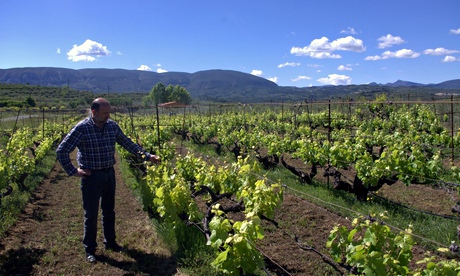http://www.nytimes.com/2013/11/06/dinin ... =dayp&_r=0" onclick="window.open(this.href);return false;

John Little, the founder and master distiller of Smooth Ambler, a West Virginia microdistillery, fell into the aged-gin business by accident. Early in 2012 he had just distilled a batch of his standard gin when he realized he was out of bottles to put it in.
“So we put it into barrels,” he said, “some into a used barrel, some into a new barrel.”
The resulting product, Chief Gowanus New-Netherland gin from New York Distilling Company, has hops as an ingredient.
The serendipitous meeting of wood and spirit was pleasing enough that he decided to leave the gin in the casks. That June, he released a few bottles. The reaction from consumers was positive, so he gave Smooth Ambler Barrel Aged Gin a bigger debut that fall. It is now tied as the company’s third-best seller, behind its bourbon and rye.
Just a year ago, aged gin could still be called an oddity. A few other small distillers were playing around with the niche spirit, including Few Spirits in Illinois, Corsair Distillery in Kentucky and Citadelle in France, which can be counted as a trailblazer, having released its version in 2008.
Today, the barrel aging associated with spirits like whiskey, rum and tequila is increasingly applied to gin. In September, St. George Spirits in the San Francisco area rolled out its Dry Rye Reposado Gin, and New York Distilling Company in Williamsburg, Brooklyn, introduced Chief Gowanus New-Netherland Gin. Last month, the industry giant Beefeater started exporting its Burrough’s Reserve to the United States.
The trend is too young and too small for anyone to have charted sales figures, but its vigor has turned heads.
“I am surprised there are so many brands out,” said Dominic Venegas, the bar director at the Winslow, a self-described “gin joint and eatery” on East 14th Street in Manhattan that carries 30 gins, including a few aged brands. “I think master distillers are learning how to do it. I think it’s going to be a niche product, but I see some of these products sticking around.”
Like almost all new products in the world of spirits, aged gin is not a new thing at all, but a reworked take on a very old practice. In the early 19th century and before, gin had to get from the distillery to the tavern somehow. Spirits were not commonly bottled, so barrels were the preferred vessels of transport.
Back then, the result was not called barrel-aged gin, because not much aging was involved. “It didn’t stay in barrels very long,” said the cocktail historian David Wondrich, who collaborated with New York Distilling on its Chief Gowanus gin. “That was very expensive. Most of the cooperage was very old. These were really resting tanks. There was no small-barrel aging being done deliberately.”
These days, it’s all very deliberate. And the choice of barrel is a crucial issue.
Most companies use old whiskey barrels. But St. George’s is aged in wine casks that have held grenache rosé and syrah, lending the juice a rosy hue. Corsair uses former spiced rum casks. Desmond Payne, the chief distiller at Beefeater, found his holy grail in casks that once held Reserve Jean de Lillet, a rarely produced vintage French aperitif.
Processes differ, too. Smooth Amber ages half a batch of gin in barrels that held bourbon, the other half in new casks, and later blends the two. To make the gin used in Burrough’s Reserve, Beefeater uses a small copper-pot still that its founder, James Burrough, worked with. Citadelle recently began to use a solera system, similar to the ones common in the sherry industry, to produce its aged gin.
The end result of all this ingenuity is a genre of spirit in which one brand often tastes nothing like the next, though most share great body and a less juniper-forward flavor than regular gin.
The aged gin from Few Spirits has strong fennel and vanilla notes. With its heavy caramel and spice notes, Smooth Ambler’s could be mistaken for a lightly aged whiskey in a blind tasting. Burrough’s Reserve is polished, drawing some French elegance from the Lillet casks. Chief Gowanus, which has hops thrown into the mix, is, in Mr. Wondrich’s words, “a little more rough and reedy, a little more engine under the hood.”
And how to drink it? The answers are as varied as the flavors. Paul Hletko, the founder and distiller of Few Spirits, said his aged gin was best drunk neat.
“Cocktails I like it for are basically whiskey cocktails,” he said, “like the old-fashioned and manhattan.” Mr. Little said his Smooth Ambler should be enjoyed straight, but added, “I think it goes pretty much anywhere gin goes, and I would prefer drinking it to standard gin.”
Mr. Payne wants people to sip his Beefeater version contemplatively, like a good Cognac, after dinner. And Allen Katz, a founder of New York Distilling, sees Chief Gowanus standing up well as half of a kopstootje, the Dutch version of a shot and a beer.
Mr. Katz — who is toying with producing an aged rendition of Perry’s Tot, the company’s navy strength gin — said he was not surprised that most of the aged gins were being produced by microdistilleries like his own. Big companies tend to focus on one type of spirit; today’s inventive and thrifty small distillers like to diversify.
“A lot of the boutique distilleries that are doing this are ones that are making whiskey and gin side by side,” he said. Making an aged gin is just a matter of cross-pollination. And, he added, aged gin is “a great use for a repurposed barrel.”










